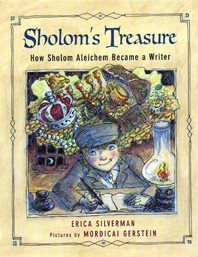Earlier this week Barbara Isenberg wrote about reminiscing with Bel Kaufman about Sholem Aleichem. She is the author of Tradition!, is an award winning journalist who has been writing and lecturing about theater for over three decades. Barbara has been blogging here for the Visiting Scribe series all week.
Broadway musicals are known for being not just written but rewritten, and many composers, lyricists and book writers have stacks of unused material in their closets or computers. With plot changes comes the need for new scenes, and with the new scenes comes the need for new songs. This was certainly the case with Fiddler on the Roof, the subject of my new book, Tradition!: The Highly Improbable, Ultimately Triumphant Broadway-to-Hollywood Story of Fiddler on the Roof, The World’s Most Beloved Musical.
When director/choreographer Jerome Robbins came onboard, he asked playwright Joseph Stein, lyricist Sheldon Harnick and composer Jerry Bock for rewrites many times. Stein wrote five drafts of his book. The songwriters turned out about 50 songs, of which the show uses fewer than one-third.
Consider the all-important opening number, for which “Tradition,” was a late arrival. Before Robbins got involved, the show opened instead with “We’ve Never Missed a Sabbath Yet,” a song about getting ready for the Sabbath that matriarch Golde sang with her daughters. Among its lyrics were cautions about getting those noodles made, chickens plucked, liver chopped and challah baked in time to light and bless the Sabbath candles.
But that song didn’t promise audiences the show Robbins had in mind. Again and again, he’d ask his authors what their musical was really about, and he refused to accept their answers that it was simply a story of a milkman and his five daughters. Finally, Harnick replied that the show was about tradition, and, replied Robbins,”That’s it. Write that.”
Today among the best-known and beloved songs ever written, “Tradition” sent “We’ve Never Missed a Sabbath Yet” scurrying. With it also went such Bock and Harnick creations as “ Poppa Help Me,” “A Butcher’s Soul,” “The Story of Jacob,” and “Baby Birds.” Gone was a love song called “As Much As That” and one of producer Harold Prince’s personal favorites, “Dear Sweet Sewing Machine.”
Similarly, Tevye first sang not “If I Were a Rich Man” but rather, “That’s Life,” a lament about his lame horse. Among its lyrics was the stanza: “So you’d like to be lazy and fat, of course/Well, it’s your rotten luck to be Tevye’s horse.” But Robbins was worried about having a real horse onstage that could make some of the highly-stylized sets look out of proportion. So he sent songwriters Bock and Harnick back to try again.
Fortunately, the songwriting team soon happened to be at a benefit when a mother and daughter came out to sing a Hasidic chant. Both men were taken with how the women substituted nonsense syllables for words, and Sheldon Harnick augmented their dedededums with some very descriptive language from Sholem Aleichem’s short stories. “I’m very smart,” Harnick once said.” I know where to take from.”
Barbara Isenberg is the author of Making It Big: The Diary of a Broadway Musical, State of the Arts: California Artists Talk About Their Work and Conversations with Frank Gehry. Her work has appeared in the LA Times, the Wall Street Journal, Time, Esquire, The Huffington Post, and London’s Sunday Times. She lives in Los Angeles. Read more about her and her work here.
Related Content:
- Tevye the Dairyman and Motl the Cantor’s Son by Sholem Aleichem
- Reading List: Jews and the Theater
- Reading List: Jews and Broadway
Barbara Isenberg, author of Tradition!, is an award winning journalist who has been writing and lecturing about theater for over three decades. She is the author of Making It Big: The Diary of a Broadway Musical, State of the Arts: California Artists Talk About Their Workand Conversations with Frank Gehry. Her work has appeared in the LA Times, the Wall Street Journal, Time, Esquire, The Huffington Post, and London’s Sunday Times. She lives in Los Angeles. Read more about her and her work here.



